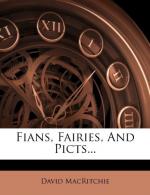In reading his book, then, for the first time, what impressed me more than anything else in his pages were statements such as the following:—
“The ancient Gauls wore helmets which represented beasts. The enchanted king’s sons, when they come home to their dwellings, put off cochal [a Gaelic word signifying], the husk, and become men; and when they go out they resume the cochal, and become animals of various kinds. May this not mean that they put on their armour? They marry a plurality of wives in many stories. In short, the enchanted warriors are, as I verily believe, nothing but real men, and their manners real manners, seen through a haze of centuries.... I do not mean that the tales date from any particular period, but that traces of all periods may be found in them—that various actors have played the same parts time out of mind, and that their manners and customs are all mixed together, and truly, though confusedly, represented—that giants and fairies and enchanted princes were men ... that tales are but garbled popular history, of a long journey through forests and wilds, inhabited by savages and wild beasts; of events that occurred on the way from east to west, in the year of grace, once upon a time” (I. cxv.-cxvi.). “The Highland giants were not so big but that their conquerors wore their clothes; they were not so strong that men could not beat them, even by wrestling. They were not quite savages; for though some lived in caves, others had houses and cattle and hoards of spoil” (I. xcix.). “And though I do not myself believe that fairies are ... I believe there once was a small race of people in these islands, who are remembered as fairies, for the fairy belief is not confined to the Highlanders of Scotland” (I. c.) “This class of stories is so widely spread, so matter-of-fact, hangs so well together, and is so implicitly believed all over the United Kingdom, that I am persuaded of the former existence of a race of men in these islands who were smaller in stature than the Celts; who used stone arrows, lived in conical mounds like the Lapps, knew some mechanical arts, pilfered goods and stole children; and were perhaps contemporary with some species of wild cattle and horses and great auks, which frequented marshy ground, and are now remembered as water-bulls and water-horses, and boobries, and such like impossible creatures” (IV. 344).
And much more to the same effect,[2] with which it is unnecessary to trouble the reader. Now, all this was quite new to me. If I had ever given a second thought to the so-called “supernatural” beings of tradition, it was only to dismiss them, in the conventional manner as creatures of the imagination. But these ideas of Mr. Campbell’s were decidedly interesting, and deserving of consideration. It was obvious that tradition, especially where there had been an intermixture of races, could not preserve one clear, unblemished record of the past; and this




